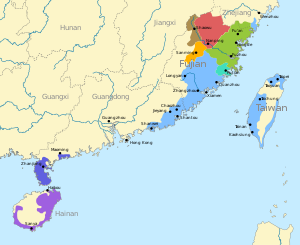
Back ደቡብ ሚንኛ Amharic مين نان Arabic مين نان ARZ گونئی مین دیلی AZB Паўднёвамінская мова BE-X-OLD Mineg ar su Breton Min nan Catalan Mìng-nàng-ngṳ̄ CDO Minnan Danish Min Nan German
This article needs additional citations for verification. (August 2016) |
| Southern Min | |||||||||||||||||||||||||||||||||||||
|---|---|---|---|---|---|---|---|---|---|---|---|---|---|---|---|---|---|---|---|---|---|---|---|---|---|---|---|---|---|---|---|---|---|---|---|---|---|
| |||||||||||||||||||||||||||||||||||||
| Geographic distribution | |||||||||||||||||||||||||||||||||||||
| Ethnicity | |||||||||||||||||||||||||||||||||||||
| Linguistic classification | Sino-Tibetan
| ||||||||||||||||||||||||||||||||||||
Early forms | |||||||||||||||||||||||||||||||||||||
| Subdivisions | |||||||||||||||||||||||||||||||||||||
| Language codes | |||||||||||||||||||||||||||||||||||||
| ISO 639-3 | nan | ||||||||||||||||||||||||||||||||||||
| Linguasphere | 79-AAA-j | ||||||||||||||||||||||||||||||||||||
| Glottolog | minn1241 | ||||||||||||||||||||||||||||||||||||
 | |||||||||||||||||||||||||||||||||||||
 Subgroups of Southern Min in mainland China and Taiwan | |||||||||||||||||||||||||||||||||||||
| Chinese name | |||||||||||||||||||||||||||||||||||||
| Simplified Chinese | 闽南语 | ||||||||||||||||||||||||||||||||||||
| Traditional Chinese | 閩南語 | ||||||||||||||||||||||||||||||||||||
| Literal meaning | "Language of Southern Min [Fujian]" | ||||||||||||||||||||||||||||||||||||
| |||||||||||||||||||||||||||||||||||||
| Notes | |||||||||||||||||||||||||||||||||||||
Southern Min (simplified Chinese: 闽南语; traditional Chinese: 閩南語; pinyin: Mǐnnányǔ; Pe̍h-ōe-jī: Bân-lâm-gí/gú; lit. 'Southern Min language'), Minnan (Mandarin pronunciation: [mìn.nǎn]) or Banlam (Min Nan Chinese pronunciation: [bàn.lǎm]), is a group of linguistically similar and historically related Chinese languages that form a branch of Min Chinese spoken in Fujian (especially the Minnan region), most of Taiwan (many citizens are descendants of settlers from Fujian), Eastern Guangdong, Hainan, and Southern Zhejiang.[4] Southern Min dialects are also spoken by descendants of emigrants from these areas in diaspora, most notably in Southeast Asia, such as Singapore, Malaysia, the Philippines, Indonesia, Brunei, Southern Thailand, Myanmar, Cambodia, Southern and Central Vietnam, as well as major cities in the United States, including San Francisco, Los Angeles and New York City. Minnan is the most widely-spoken branch of Min, with approximately 48 million speakers as of 2017–2018.[5]
The most widely spoken Southern Min language is Hokkien, which includes Taiwanese. Other varieties of Southern Min have significant differences from Hokkien, some having limited mutual intelligibility with it, others almost none. Teochew, Longyan, and Zhenan are said to have general mutual intelligibility with Hokkien, sharing similar phonology and vocabulary to a large extent.[6] On the other hand, variants such as Datian, Zhongshan, and Qiong-Lei have historical linguistic roots with Hokkien, but are significantly divergent from it in terms of phonology and vocabulary, and thus have almost no mutual intelligibility with Hokkien. Linguists tend to classify them as separate languages.
- ^ Mei, Tsu-lin (1970), "Tones and prosody in Middle Chinese and the origin of the rising tone", Harvard Journal of Asiatic Studies, 30: 86–110, doi:10.2307/2718766, JSTOR 2718766
- ^ Pulleyblank, Edwin G. (1984), Middle Chinese: A study in Historical Phonology, Vancouver: University of British Columbia Press, p. 3, ISBN 978-0-7748-0192-8
- ^ Hammarström, Harald; Forkel, Robert; Haspelmath, Martin; Bank, Sebastian (2023-07-10). "Glottolog 4.8 - Min". Glottolog. Leipzig: Max Planck Institute for Evolutionary Anthropology. doi:10.5281/zenodo.7398962. Archived from the original on 2023-10-13. Retrieved 2023-10-13.
- ^ Cai Zhu, Huang Guo (1 October 2015). Chinese language. Xiamen: Fujian Education Publishing House. ISBN 978-7533469511.
- ^ Southern Min at Ethnologue (23rd ed., 2020)

- ^ Lee, Tong Soon (2009). Chinese Street Opera in Singapore. University of Illinois Press. ISBN 9780252032462.